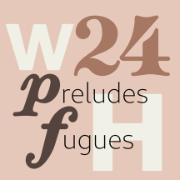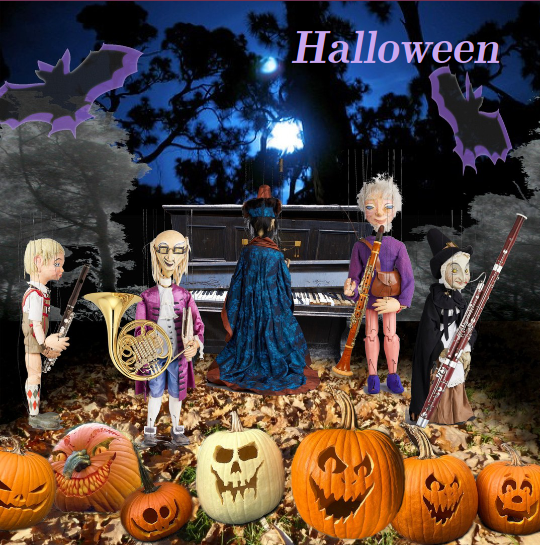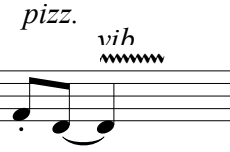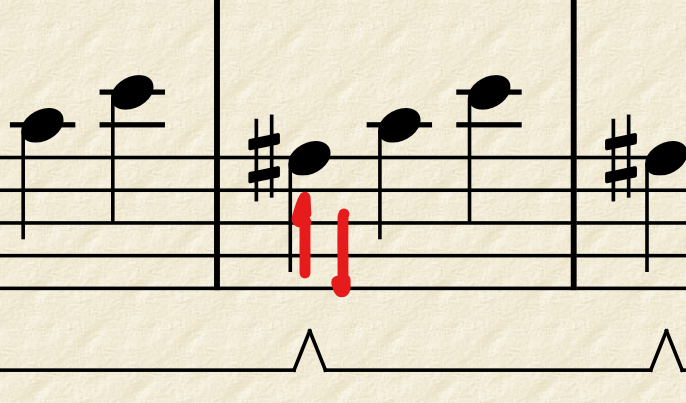All Activity
- Past hour
-
Micah started following Submissions Thread - Fall 2025 Halloween Competition
-
Submissions Thread - Fall 2025 Halloween Competition
Micah replied to PeterthePapercomPoser's topic in Monthly Competitions
Here is my submission. The whole string quintet is 5 movements, but I've just given the first 3 to fit the time slot. It's a link to the Google Drive folder with the WAV files and score. https://drive.google.com/drive/folders/1MD4VU4YyL0m1n5gULbGStdbZU396P_oN?usp=sharing I hope I put this in the right place- I'm quite obtuse when it comes to this website. - Today
-
This is my contribution to the YCF Fall 2025 Halloween competition: First the story: On the last evening of October, you take a walk to the nearby urban forest. In the shade of the trees, dimly lit by moonlight and distant streetlights, you spot five figures. They're not ghosts or other sinister creatures, but musicians who – somewhat awkwardly, like marionettes – are performing their Halloween serenade. All this puppets – while playing perfectly together – have their own character: The pianist hides behind his slightly out-of-tune piano. The flute player trembles a little nervously, while the horn player sometimes blares loudly, the clarinetist and the bassoonist alternate between playful and calm roles. After the last melancholic chord has faded away, the wind picks up, swirling the leaves on the forest floor. The rain begins to fall and the illusion disappears into the mist. Now some musical explanations about the piece: The piece is derived from my Prelude XVIII in G sharp minor, arranged as a piano quintet with woodwinds as the accompanying instruments, in that particular case flute, clarinet, French horn and bassoon. For me, the key of G sharp minor has a mystical and gloomy character and since the piece features many dissonances and rich chromaticism - together with the usage of the tritone as a central interval – it seems to fit perfectly with the subject of the competition. Here is the structure of the piece, composed in sonata form: 0:07, mm. 1 – Exposition, 1st Theme: The first thematic material (highlighted in purple) consists of a quartet of chromatic runs and syncopations that can be easily be distributed among the four woodwind instruments, achieving a playful character – in spite of the dissonances. 1:02, [E], mm. 30 – Exposition, 2nd Theme: As the second theme (highlighted in blue) I quote the subject of the subsequent Fugue XVIII in A flat minor in a rather chorale-like and calm form. 1:25, [G], mm,46 – Exposition, Codetta: Repetitive notes (highlighted in green) form the thematic material of the codetta, first in chords accompanied by the bassoon, and finally as a tutti. 1:52, [H], mm.55 – Development: In the short development section, the augmented second subject and the chromatic runs and syncopations from the first theme interwove together. 2:40, [K], mm. 78 – Recapitulation: In the recapitulation, the instruments change their roles, picking up the voices from their counterparts and swapping solo vs. tutti sections to avoid a simple repetition of the exposition. The codetta with plaintive chords finally descends in a morendo to the minor triad. Here is the score: Piano quintet in G sharp minor
-
M. Gomes Santos started following A Waltz made for piano, but orchestrated
-

Fall 2025 Halloween Competition
Kvothe replied to PeterthePapercomPoser's topic in Monthly Competitions
Great! I will be looking forward seeing @ferrum.wav and @Wieland Handke entries. If @Micah submits his, then I can score that. 🙂 Do not rush your entries. Submit what you have. And see what happens. -

Fall 2025 Halloween Competition
Wieland Handke replied to PeterthePapercomPoser's topic in Monthly Competitions
I nearly finished my work and intend to post my contribution today, in about a few hours. -

CLOWNS - Fall 2025 Halloween Competition Submission
Omicronrg9 replied to sebastian Pafundo's topic in Chamber Music
SPANISH VERSION Hola Sebastián. Te contesto en español y luego lo traduciré al inglés todo para que la gente lo pueda leer. En general aquí hablamos en inglés pero no te preocupes, no es problema dedicar un par de líneas en el idioma de Cervantes a tu pieza. Es una pieza que no me ha disgustado para nada. De hecho, teniendo en cuenta que has usado los sonidos del general midi no suena tan mal. La idea se entiende. La ejecución de la idea ya es otro cantar. Me he fijado en esto: Imagino que a menos que el gliss. termine arco arriba el pizzicato instantáneo está complicado de hacer. Puede comportar una dificultad innecesaria, pero si a ti te gusta como está no hay más que hablar. La pieza en sí no abandona la disonancia pero tampoco se va tan lejos como para provocarme aversión o disgusto. Generas una atmósfera de suspense que con instrumentos de verdad o con mejores sonidos (soundfonts mejores o usando librerías) estoy seguro de que funcionaría muy bien. El final, sin embargo, no me convence, pero en este caso no sé si atribuirlo a la pieza o al sonido, que no ha permanecido todo el tiempo necesario para dejar la tensión suspensiva que has creado el tiempo suficiente. Viendo la partitura diría que es lo segundo. En referencia a la partitura en sí, menudos márgenes! Yo soy muy de ajustarlos mucho, pero creo que incluso para alguien que no esté de acuerdo conmigo y prefiera márgenes más anchos, diría que te has pasado. Puedes aprovechar mucho mejor el espacio y aún manteniendo márgenes grandes, hacer también más grandes los pentagramas y facilitar la lectura. No sé qué programa de composición usas, ¿quizá una versión antigua de Sibelius?. Si no te importa comentármelo a lo mejor podemos entender qué ha pasado aquí, por ejemplo: Estos son solapamientos extraños que no he visto en versiones modernas de este tipo de software, pero vete tú a saber. Haces un uso extensivo (que no abusivo) de los matices, cosa que es inteligente siempre y cuando se haga correctamente. Lo tienes todo bastante bien marcado y de no ser por los márgenes tan anchos yo creo que la maquetación te habría quedado bastante bien (que no está mal, es mejorable. Hay cada cosa...). La pieza, según el midi, dura 2:59, que en interpretación real yo creo que llega a los 3 minutos fácil, ✅. Lo que te dicen los demás usuarios del foro no va desencaminado en mi opinión. Creo que a tu motivo le quedan kilómetros por recorrer. No me extiendo más! Muchas gracias por participar Sebastián, ojalá sigas componiendo (y pasándote por aquí 😀). Un saludo, Daniel–Ø. Ø ENGLISH VERSION Hi Sebastián. I’m replying in Spanish first and then I’ll translate everything into English so everyone can read it. We generally speak English here, but don’t worry—it’s no problem dedicating a couple of lines in the language of Cervantes to your piece. It’s a piece that I didn’t dislike at all. In fact, considering you’ve used General MIDI sounds, it really doesn’t sound bad. The musical idea comes through clearly. The execution of that idea is another story, though. I noticed this: (First IMG) I imagine that unless the glissando ends with the bow moving upwards, an instant pizzicato is quite tricky to execute. It could create unnecessary difficulty, but if you like it as it is, that’s totally valid. The piece itself doesn’t abandon dissonance, but it doesn’t go so far as to provoke aversion or discomfort. You manage to create an atmosphere of suspense that, with real instruments or better sounds (using improved soundfonts or libraries), I’m sure would work really well! The ending, however, doesn’t quite convince me. But in this case, I’m not sure if it’s the piece itself or just the sound, which didn’t sustain the tension you created for long enough. Looking at the score, I’d say it’s probably the latter. As for the score margins… wow, those are wide! Personally, I like to make margins tight, but even for someone who prefers wider margins, I think you may have overdone it a bit. You could make much better use of space, and even with big margins, you could enlarge the staves and make reading easier. I’m curious...What notation software do you use? Maybe an old version of Sibelius? If you don’t mind sharing, maybe we could figure out what happened (Second image). These are some strange overlaps I haven’t seen in modern versions of this kind of software, but who knows. You make extensive (but not excessive) use of dynamics, which is smart as long as it’s done properly. You’ve marked everything fairly clearly, and if not for the wide margins, I think your layout would have turned out quite well (and it’s not bad as it is, it just could be improved). According to the MIDI, the piece lasts 2:59, which I think would easily reach three minutes in real performance. What the other forum users say is pretty much on point in my opinion. I think your main motif still has a lot of potential for development. I’ll stop here! Thank you very much for sharing, Sebastián—I hope you keep composing (and dropping by here). Best regards, Daniel–Ø. -
@therealAJGS I attached it here. Woodwind Quintet No. 1.mp3 I hope you do not mind, @Maxthemusicenthusiast! If this had any bossa feeling, you made sure to change it completely. One can still perceive the rhythm but it's something utterly different. Hi Max, and welcome to the forums! Interesting notation here: I am not too used to it and I myself don't use it, but it's cool and convenient for some and I totally understand why! I agree with @Thatguy v2.0, first part of the piece seemed like a prelude and I liked it despite of the MIDI sound (that doesn't actually bother me because of videogames I played in the past, I believe). I also agree that the fast part ends a bit too soon to my taste, but you created a very nice theme, really I think you found some gold combining the slowed down bossa nova rhythm with these dissonant passages. You take your time and don't go farther away, which I like, as sometimes we are tempted to break rules in all directions due to having broken some on a single one. I am glad you did not do that, consciously or not. You make good use of dynamics, articulations, and your writing contains nothing incredibly difficult. This piece you submitted suggests me you do know your craft, you did not rush the end, and I feel balance when I listen to your piece over and over again. It doesn't sound very Halloween-ish to me, though, but it doesn't really need to. The work is sober, but solid, and it does a good job by portraying some indeed sinister place in my honest opinion. It does transmit uneasiness to me, but at the same time, it doesn't let me go far away and keeps me there, uneasy, but enjoying nonetheless. Shall I repeat again, the ending did convince me. Very good job. Thank you for your submission, I hope you stay around! Kind regards, Daniel–Ø.
-
Hi Tristan. I'll try to be brief: your material is decent. I'm not puttin' grades in this informal competition but some variations here are not of my taste and would not pass. Others, maybe. I am not sure myself, for 4 hands at least. Passages like these seem very difficult to get right for one hand only: , had it been a B natural I would see it more feasible but with the speed demanded and the time you are required to sustain it, well I agree with MK's point: performers would ask you to change stuff right away or pass it off. If this is what you truly like though, don't hesitate to follow your path but be aware of the shortcomings when it comes to publish. Where is variation 12? Is the one that began at M248 perhaps? The score seems to go from 11 to 13 "Alla de Var. 12" but I don't see the Var. 12 marked. If it's that one, it's among my favourites along Var. 8. Regarding the engraving, the score is pretty much unrevised as likely 90% of scores submitted to musescore so no biggie, just another day in the job. Standard. Since it's not very heavy on content off-staff there are not overlaps (or I didn't detect any in a superficial analysis) and that's definitely a good thing. With this piece, in summary, I did like some things, disliked some others... So it ended up being about even, except for the final. Thank you for your submission, Tristan. Keep composing! Kind regards, Daniel–Ø.
-
Hi, HoYin Cheung! Bear with me for a small while this time. Couldn't resist to quote this, I think it's a very good way to define the difficulty of some parts of this score. It doesn't seem to be an easy feat for neither the strings nor the pianist (perhaps the pianist has less trouble than the violin though!). I am in partial agreement with @MK_Piano here. I do appreciate the atmosphere you created in some parts (the piano solo w/pedal part for example), but after a couple of listenings, and while being true that "I wouldn't mind listening to it again" (and so I did, many times already), there is essentially nothing that makes or would make me gravitate towards this piece enough to listen to it much longer. At this point, I may have heard hundreds of these pieces, part here at YC or other forums such as free-scores, part LIVE, and while I honestly think you did a good job with the score and you probably took a while to write all of this... Truth is, that after the less and less likely initial surprise/shock it went directly to the same far away place in my mind that I am no longer curious to explore or remember. It just melt, liquid; fused with an immeasurable and diffuse blob of notes, clusters and dissonances that are all different yet they feel the very same and which time has taught me to withstand but never to enjoy. Truth is, I very rarely enjoy "contemporary" pieces of this kind, more of a mesh of dissonances stained with interesting material than anything else. They almost always simply "go through", and this one was sadly no exception. However, I would say the ending of this piece was ok, which is five to ten orders of magnitude better than what I usually think of ending sections/passages/bars of pieces that more weakly or strongly (I guess that's again subjective) resemble your piece. And as a rule of thumb with all pieces that come with a description first, I tend to have a listen or two before I read it. Now it would be impossible to me to tell you if reading it beforehand would have influenced me enough to be in agreement with what you claim to portray with your piece, but by having done the opposite process I can guarantee you that from my humble and maybe very wrong opinion (not only because I am not familiarised with Gaelic culture but because I am familiarised with the particular sound of this particular style of contemporary music) this piece did not evoke anything related with the story, not any more than other pieces or parts in pieces like...Dunno: • String Quartet No.1 - Javier Torres Maldonado • Ligeti: String quartet No.2 - Arditti quartet. Just in case, I am not sure if these are composers of reference (they ain't very famous but they ain't precisely unknown either) or that they do mimic your work, this is not what I tried to convey here. Finally and despite my not very benvolent words I would still judge your piece at least one or two orders of magnitude above any section of these two examples I have provided had they been brought to this informal cozy contest, so they may not do justice to the work of yours. All in all, thank you for your submission! Best regards, Daniel–Ø.
-
Hi again man, it's me, the long reply guy again! But this time I'm having a look at your quartet :). How important structure is. If there's anything I love listening to that would be 100 of 100 times how apparently simple stuff gets way stronger than what one can anticipate making intelligent use of structure. What first felt like a nice but not specially remarkable rhythm and material, later came back strengthened. It's something that our grand masters of the past knew very well and I personally never get tired of it. This is a very solid and aesthetically beautiful (in my humble opinion) quartet which although it doesn't stand out for doing anything revolutionary, it definitely doesn't need to! It handles very well the essential elements that make it up, and if this weren't an informal competition and I were to evaluate it seriously, it would be among the best pieces submitted these days. We have different tastes when it comes to engraving (I am not into rehearsal marks with bar numbers or big tempo indications, but I very much understand their usefulness). That aside, your score is very well engraved, again in my opinion. Congratulations and thank you for your great submission. Best of luck and...Hope you stay around! Kind regards, Daniel–Ø.
-

A hollow theme for Halloween (Fall 2025 competition)
Kvothe replied to therealAJGS's topic in Electronic
@therealAJGS I would not mind helping you in making sure you score that looks pretty and such. Also, a great book is Behind bars. 🙂 -

A hollow theme for Halloween (Fall 2025 competition)
Omicronrg9 replied to therealAJGS's topic in Electronic
Hi TherealAJGS. Nice drrrrumset! It needs a bit (or a lot, depending on how tolerant your ears be) of production cause there are parts where the sounds turns into a wall and it gets perhaps too muddy —Maybe that's your thing, though—. There's little dynamic shift apart from the one belonging to the instruments being present or silent into the piece which BTW, there are prolly more than five, right? I won't consider the score, I just took a look and it's a mess, only two staves, missing drumset (or worse, drumset into the parts with tuned instrument notation), and we could go on and on! But don't worry about it. IF you're interested, you may learn bit by bit, sooner or later. Imho score engraving is something interesting and worth learning. Music theory of any kind is as well, but you probably know that and I don't wanna be that guy! Now, the piece itself after 2-3 listenings seems a bit over the place to me. The arpeggio-motif is almost always present as some kind of glue but following that metaphor I think there's an excess of glue on the whole theme. It's like when you add so much ketchup to the burger that the burger ends up becoming ketchup, but with some meat. Combine that with the, again, lack of dynamics aside of "volume dynamics" (in terms of number of instruments) and prolly automatic sound normalisation and you get something with lots of room for improvement. It has potential, yes; the part in which you get the drumset going is awesome, and I would have liked more of that. But I believe it's raw and unpolished in terms of sound, but also in terms of structure. The beginning is also good. The ending, though, did not convince me at all. The halloween-ish sound, well you did include harpsichord and organ, but it sounds to me more like the tune for the local boss of this region (beta version), which isn't bad either, at least in my opinion. Thank you for submitting your piece and for participating in this little cozy informal contest :). Kind regards, Daniel–Ø. -
Welcome to the forums! You can comment anywhere you want as long as you follow the rules which are basically common sense (welp I didn't read them but they're probably not so strict)! Regards!
-
Welp man, this is a full horror medley. Very cool ending, nothing to complain about, maybe some automatic overlaps in the score here and there but these are tiny details and it's not like I spotted many. You fully captured the feeling, that's undeniable. And the more I listen to it, the more seamless it feels and the more coherent its parts become together. Nicely used harmonics in the "B part". this ain't just "here you go, some effects" and call it a day. It's a very difficult (or so it seems) but solid scary dissonant quartet. My favourite part is this somewhat cantabile melancholic melody you manage to do in the middle of this dissonance of a quartet (in the good way) that leads again to a B' (because of the triplets). And let me mention again, the ending is very solid, very cool. I don't quite get the title, so it's a 4/10, sorry... 🤑 I'll vote for you Kind regards!!
-
@Tunndy what great start to piano writing. Below, you will find feeback, and I hope helps. Harmony: You've piece in Gb flat major, which is probably a hard key to read (especially if you have double sharps and flats). I feel if you transpose it G to F it would make easier for young musicians to read. (Think about that). The harmony is entirely diatonic: I, IV, and V. It would be easier to read if we had waltz pattern was in the bass and melody in treble. Melody and motives: The motive of chords is nice book end that begin and ends piece. The middle, however, needs a melody. Something that says: Hey this new! Form: As a short piece, it is well done. Over all: there are things to improve upon. I feel that is composition has room improvement. Maybe you have understand core ideas, slowly move to advance ones.
-
HI @BipolarComposer May we please see the score?
-
Hi @Tunndy! I think the piece is in Gb major rather than D# major! D# major doesn't really exist as a key signature as it would have contained 8 sharps with F double sharp! A funny waltz with the running notes figure, and you can definitely extend both ideas! Henry
-
Henry Ng Tsz Kiu started following my first piano piece
-
therealAJGS started following EnriqueMZ
-
Hi again man. I took note of all your comments (and @Kvothe's) and prepared a second edition featuring a score pretty much like I saw it in your examples. System dividers + rehearsal marks have been added. The other parts are reduced. I maintained my usual engraving style but added most of what you mentioned in the Piano+ part. I didn't abuse of rehearsal marks because they were on top of the already present measure numbers. Best regards!
- 11 replies
-
- 1
-

-
My God Kvothe. Didn't see your other scores you've put but no matter what but you made my night sir. Many thanks! This is my intention: when I put the pedalling like that, pedal should go up and down a just a bit after the first note of each bar sounds, while you're still sustaining it with your finger, so there's gonna be ideally close to no emptiness. Doing it on the 2nd or 3rd beat like this would produce the same thing , it would sustain 3 notes too, but not the three I want sustained at the same time. Very subtle, though, I could have gone with any other pedalling and it would have prolly worked more or less as good. Yes, at least that should be the case, though I guess it depends on the piano and the room as well. It may have been too much so I cut it down a bit, thanks for the heads up! This is very true, but I hoped the score itself to be easy enough so violin players could do it without issues. I've had another look at it, thank you man. I added an ossia in the only part where I see this very problematic, as in other switches you either have silences or morendo.
- 11 replies
-

Fall 2025 Halloween Competition
ferrum.wav replied to PeterthePapercomPoser's topic in Monthly Competitions
Yep -
PeterthePapercomPoser started following All Hallows Eve
-
.thumb.png.8b5b433a341551e913a34392660bc95b.png)
Fall 2025 Halloween Competition
PeterthePapercomPoser replied to PeterthePapercomPoser's topic in Monthly Competitions
Just a reminder for everyone that the competition doesn't close until Friday October 31st, 11:59 pm PST and more music can still be submitted by then! The following people have declared their intent to participate but have not yet submitted music: @ferrum.wav @Wieland Handke @Micah Do you still intend to submit music before the deadline? - Yesterday
-
I'm not going to go against you Henry, for some of my old pieces (some of my favourite ones) I no longer have the scores for some of them, the pieces that I would like the most to have with scores, I don't know if there is any solution for this but anyway, so where do I ask for that if want some my pieces to have a clear and actual score (because I don't like so much some of them but I would like to for some specific ones)
-
Henry Ng Tsz Kiu started following All Hallows Eve and First species counterpoint!
-
Well, if you want to have others playing your pieces then a score is definitely necessary. Even if it's just for your self enjoyment, a better scoring and engraving will help clarify your own thoughts towards your piece and will definite affect your final result of writing! Henry








